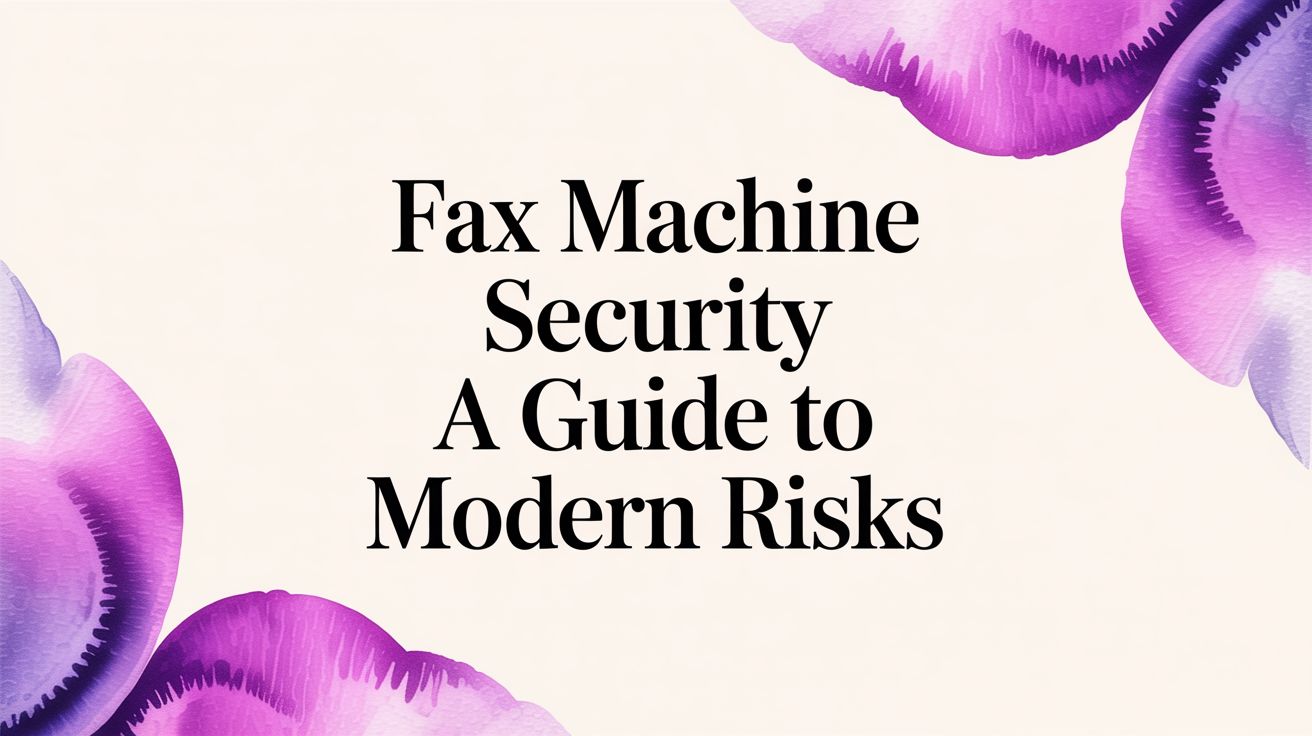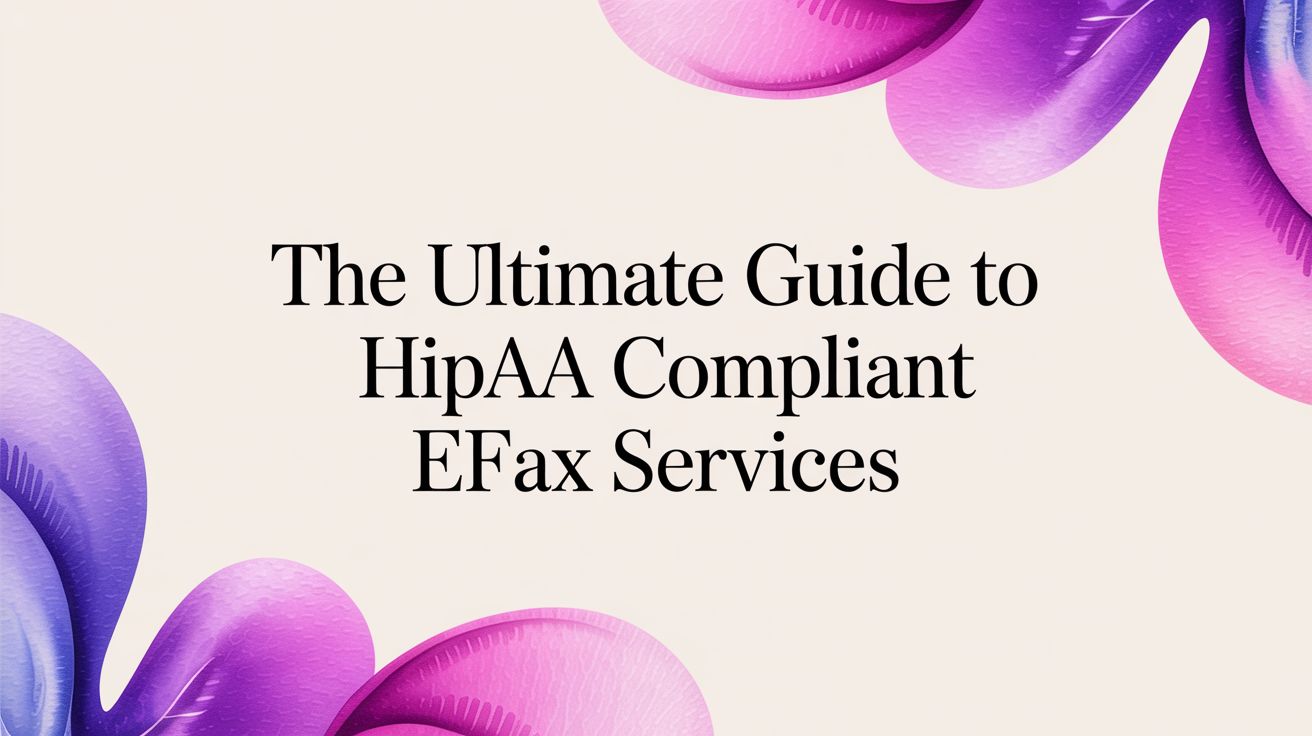Are Fax Machines Secure? A Guide to Modern Risks

Table of Contents
Fax machine security is a topic most offices completely ignore. But here's the uncomfortable truth: that old machine humming in the corner could be a significant data breach waiting to happen. The biggest threats aren't always sophisticated cyberattacks; they are often shockingly simple things, like sensitive documents left sitting on the output tray or a fax accidentally sent to the wrong number. These everyday oversights can expose confidential information just as easily as a complex hack.
Ready To Fax?
Start sending faxes online in seconds with FaxZen - No account required
Send Fax Now 🚀Thinking about upgrading your communication security? See how modern, secure solutions from FaxZen can protect your sensitive data.
Why Your Fax Machine Is a Hidden Security Risk
For decades, the fax machine has been a fixture in business, viewed as a reliable way to send documents. Because they traditionally operate on phone lines, many people assume they are disconnected from the internet-based threats that constantly target email and cloud services. This perception creates a dangerous blind spot in a company's overall security strategy. In reality, the very simplicity of a traditional fax machine is what makes it so vulnerable to both physical and digital threats.
The most common and immediate risks are physical. Picture a busy office where one fax machine is shared by HR, accounting, and sales. When a sensitive contract or a client's financial records arrive, they land in the output tray, often in plain sight for hours. Anyone walking by—an employee from another department, a visitor, or even the cleaning crew—can see, photograph, or simply take the document. This single point of failure turns every shared fax machine into a potential data leak, requiring zero technical skill to exploit.
Beyond forgotten documents on the tray, human error introduces another layer of risk. Sending a fax means manually dialing a phone number. One wrong digit, and confidential information is now in the hands of a complete stranger. Unlike email, where a wrong address often gets you a bounce-back notification, a misdialed fax usually just goes through without any immediate alert. This risk is amplified when dealing with a high volume of faxes, as the repetitive, manual nature of the task makes it easy for employees to become careless. It's a key point of discussion in the fax vs email security for business debate.
The Unseen Threat of Unencrypted Transmissions
The core technology behind faxing hasn't changed much in over 40 years. These devices were never designed for an era where every piece of office equipment could be an entry point into a corporate network. Even if you aren't targeted by a sophisticated hack, traditional faxing has a fundamental weakness: the transmissions are completely unencrypted. When you send a fax over a standard phone line, the data travels as a raw, unprotected signal. Anyone with the right equipment can tap that line and intercept the entire document.
Intercepting a traditional fax is the digital equivalent of someone opening your mail. The information is transmitted in the clear, with no built-in protection against eavesdropping.
This turns every fax containing financial records or client contracts into a massive liability. The problem is compounded as businesses modernize their phone systems. Many have switched from old-school analog lines to Voice over IP (VoIP) systems to cut costs. When a fax is sent over a VoIP network, it's chopped up into digital packets and sent across the internet. Without strong encryption, those packets can be intercepted, captured, and reassembled by anyone snooping on the network. This digital exposure is a key reason why any modern online fax service comparison places such a heavy emphasis on encryption.
| Transmission Method | Primary Vulnerability | Attack Method |
|---|---|---|
| Traditional Analog Line | Lack of Encryption | Physical Phone Line Tapping |
| VoIP System | Internet Exposure | Digital Packet Sniffing |
How Online Faxing Solves Legacy Security Flaws
The old way of faxing is full of security holes, from papers left on the machine to taps on the phone line. The real solution is to rethink the entire process, and that’s exactly where secure online faxing comes in. It’s a complete upgrade that builds security in from the ground up, tackling every weakness of traditional machines with modern digital safeguards. This shift takes faxing from a clunky, hardware-based task to a smart, software-driven workflow.
The single biggest security boost you get from online faxing is end-to-end encryption. A traditional fax travels over phone lines as a raw, unprotected signal. Modern services wrap your documents in a layer of powerful cryptographic protection, typically using Transport Layer Security (TLS), the same technology that protects your credit card details when you shop online. Top-tier services also encrypt your documents while they're stored, using standards like AES-256. This means your faxes are protected not just on their journey, but also in your digital account.
Online faxing also instantly gets rid of the most common vulnerability: the unattended output tray. Faxes are delivered directly to a person's secure email inbox or a password-protected online portal. No more physical paper sitting in a public space. This simple change guarantees that sensitive information is only seen by the intended recipient, transforming fax delivery from a public broadcast into a private, secure message. You can see how this process works in our 2025 guide on how to send a fax online.
Finally, online faxing creates a rock-solid, auditable record of every single action. Every fax you send or receive is logged with a precise timestamp, the destination number, and its delivery status. This gives you an irrefutable audit trail that's invaluable for compliance or investigating a security incident. Unlike the flimsy confirmation sheet from a traditional machine, a digital record is permanent, detailed, and secure. Teaching teams to securely send a fax via email can streamline this entire process.
Frequently Asked Questions (FAQ)
1. Are faxes sent over the internet secure?
When sent through a reputable online fax service, yes—they are significantly more secure. Good services use robust encryption like Transport Layer Security (TLS) to protect your documents as they travel across the internet. The best services also encrypt your faxes while they are stored on their servers, providing end-to-end protection.
2. Can a fax machine be hacked?
Absolutely. A modern all-in-one printer/fax machine is essentially a small computer on your network. Security researchers have shown that attackers can send a specially crafted fax containing malicious code to take control of the device and then use it as a gateway to attack your entire internal network. This is a crucial element of network security planning.
3. What is the most common fax security risk?
By far, the most common risk is physical access. Leaving confidential documents unattended in the output tray of a shared office fax machine is a simple but severe security breach waiting to happen. Anyone walking by can view or take sensitive information.
4. How does sending a fax to the wrong number happen?
It is almost always due to human error. Manually typing a long fax number makes it incredibly easy to transpose digits or make a typo. Once sent, there is usually no way to recall the fax or even know for sure that it went to the wrong person.
5. Do I need a physical fax machine for online faxing?
No, not at all. An online fax service completely replaces the physical hardware. You can send and receive faxes from your email, a web browser, or a mobile app, eliminating the costs of paper, ink, and a dedicated phone line.



